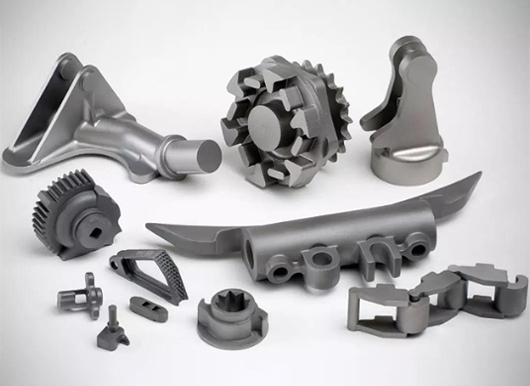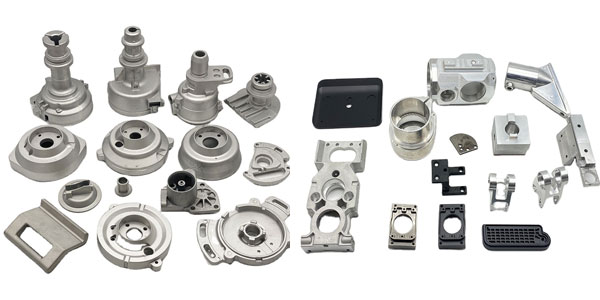How Aluminum Castings enhance product performance in modern industries
Checking Out the Versatile Makes Use Of and Applications of Aluminum Castings in Modern Industries
Light weight aluminum castings have actually ended up being integral to different modern sectors because of their distinct properties. They use significant benefits in weight decrease, thermal conductivity, and rust resistance. From auto advancements to applications in durable goods and building, their adaptability is impressive. The true level of their effect extends beyond instant benefits, hinting at wider implications for sustainability and efficiency. What exists ahead for aluminum castings in an ever-evolving industrial landscape?
Automotive Market Innovations
The auto sector has actually progressively accepted light weight aluminum castings to boost lorry efficiency and effectiveness. By using aluminum, manufacturers can generate lighter elements, which add to boosted gas economic climate and reduced discharges. Secret applications consist of engine blocks, transmission cases, and structural parts, where the product's strength-to-weight ratio supplies resilience without including excess weight.
Light weight aluminum spreadings also use remarkable thermal conductivity, which aids in far better warmth dissipation, thus improving engine performance. Improvements in casting technologies, such as die spreading and sand casting, allow the manufacturing of complicated geometries, allowing for ingenious layouts that maximize space and functionality.
The recyclability of light weight aluminum lines up with sustainability objectives in the automotive market, advertising eco-friendly practices. As the industry remains to innovate, the usage of aluminum castings is most likely to broaden, driving additional developments in lorry layout and efficiency.
Aerospace Developments and applications
While the aerospace industry remains to prioritize weight decrease and fuel effectiveness, light weight aluminum spreadings have become a critical product selection for different applications. Their light-weight nature, paired with high strength-to-weight proportions, enables significant enhancements in aircraft performance and performance. Aluminum castings are frequently used in structural parts, such as body structures and wing parts, where decreasing weight is essential.
Current advancements in aluminum casting modern technologies, consisting of boosted alloy formulations and accuracy spreading strategies, have better enhanced the product's efficiency capabilities. These advancements allow the production of intricate geometries and detailed designs while maintaining architectural integrity. Additionally, aluminum's outstanding rust resistance warranties durability and dependability in extreme aerospace environments.
As the aerospace field increasingly accepts sustainability, light weight aluminum spreadings use a recyclable service that aligns with eco-friendly techniques, making them an essential element in the development of next-generation airplane.
Durable Goods and Everyday Products
As customers significantly look for lightweight yet sturdy products for day-to-day products, aluminum castings have gained popularity in numerous consumer goods. The one-of-a-kind buildings of light weight aluminum, including its resistance to deterioration and exceptional thermal conductivity, make it a suitable selection for products like pots and pans, home home appliances, and exterior equipment. Light weight aluminum cast pans and pots supply even warm circulation, enhancing cooking effectiveness. Furthermore, the use of aluminum in products such as bicycle structures and baggage assures an equilibrium in between stamina and mobility. Manufacturers appreciate aluminum castings for their flexibility, as they can be quickly built into complicated shapes while keeping structural honesty. The capacity to recycle light weight aluminum without weakening its homes straightens with expanding customer preferences for lasting products. In general, light weight aluminum spreadings are essential to the manufacturing of durable, useful, and cosmetically pleasing durable goods, satisfying the needs of modern way of lives.
Building and Architectural Uses
Aluminum spreadings have become a crucial component in construction and building style, especially due to their stamina and light-weight nature. These homes make light weight aluminum an optimal selection for various applications, consisting of structural components, exteriors, and attractive features - Metal Castings. Architects and contractors progressively use aluminum spreadings for home window frameworks, doors, and roof, boosting both capability and appearances. The product's resistance to rust even more expands its life expectancy, minimizing upkeep expenses and making certain longevity in varied environmental problems
Aluminum can be quickly molded right into intricate designs, permitting for ingenious architectural expressions. Its versatility facilitates the production of personalized pieces that meet particular design demands, from elaborate railings to complicated assistances. As sustainability ends up being a top priority, aluminum's recyclability includes to its allure in environmentally friendly building and construction techniques. Overall, aluminum spreadings are revolutionizing the construction industry by offering lightweight, long lasting, and aesthetically attractive remedies.
Electrical and Electronic Elements
Light weight aluminum spreadings play an essential role in the production of lightweight electrical enclosures, which enhance transportability and effectiveness in numerous applications. On top of that, their exceptional thermal conductivity makes them excellent for warmth sinks, making certain peak efficiency and durability of electronic components. Aluminum's conductive properties add to its usage in different electrical conductors, stressing its value in modern innovation.
Light-weight Electric Units
Lightweight electrical units play a vital function in safeguarding sensitive electronic components from ecological aspects and physical damages. Built from aluminum castings, these enclosures are valued for their strength-to-weight proportion, making them suitable for different applications throughout markets. Their light-weight nature aids in reducing general system weight, which is important in portable and mobile electronic devices. Light weight aluminum's corrosion resistance improves durability, prolonging the lifespan of the enclosed parts. The capacity to mold and mildew light weight aluminum right into complicated forms enables personalized layouts, catering to specific requirements while making sure effective heat dissipation. Furthermore, these units can be easily integrated right into existing systems, providing versatility and adaptability in modern-day technological settings. In general, light-weight light weight aluminum enclosures significantly add to the performance of digital devices.
Warm Sinks and Conductors
While several materials are used in electronic elements, light weight aluminum spreadings attract attention for their performance in heat management as heat sinks and conductors. Their outstanding thermal conductivity enables for reliable warmth dissipation, which is essential in preventing the getting too hot of More hints digital tools. Aluminum's lightweight nature further enhances its suitability for applications where weight is a significant variable, such as in aerospace and auto industries. In addition, light weight aluminum spreadings can be conveniently built right into complicated shapes, supplying style versatility for enhancing thermal performance. The corrosion resistance of aluminum also adds to the long life and reliability of these parts in numerous settings. As innovation advancements and devices become extra small, the demand for effective warmth management solutions, like aluminum spreadings, remains to expand.
Marine Industry Usage
The marine industry increasingly relies upon light weight aluminum castings for their remarkable sturdiness and corrosion resistance. These residential or commercial properties make aluminum an excellent option for various applications, consisting of boat hulls, engine components, and aquatic hardware. The light-weight nature of light weight aluminum castings makes it possible for enhanced gas effectiveness and easier ability to move in watercraft, which is important for both entertainment and industrial vessels.

Light weight aluminum spreadings also provide substantial expense benefits as a result of their lengthy lifespan and low upkeep demands, minimizing the overall functional costs for marine drivers. Furthermore, the convenience of light weight aluminum enables intricate layouts that can meet details performance requirements.
Makers in the aquatic market utilize innovative casting strategies to produce intricate shapes, making certain that elements meet strenuous security and efficiency requirements. As the need for high-performance marine vessels expands, aluminum castings are positioned as a vital material in boosting the functionality and durability of aquatic devices.
Sustainability and Recycling in Light Weight Aluminum Spreading

Aluminum Recycling Refine
Recycling light weight aluminum plays an essential role in reducing ecological impact and saving resources within the spreading industry. The aluminum reusing process begins with the collection of scrap aluminum, which can include old elements, making waste, and post-consumer items. This scrap is then sorted, cleaned up, and shredded right into little pieces to assist in melting.
As soon as prepared, the aluminum scrap is thawed in a furnace at reduced temperature levels than main light weight aluminum manufacturing, significantly reducing energy usage. The liquified light weight aluminum is after that cast into ingots or various other forms for reuse in numerous applications - Aluminum Foundry. This closed-loop system permits for the reliable recovery of aluminum, preserving its residential or commercial properties while minimizing the requirement for virgin materials. The reusing process is an important part of sustainable practices in light weight aluminum spreading.
Ecological Benefits
While light weight aluminum casting plays a vital duty in different industries, its ecological advantages are especially remarkable concerning sustainability and resource preservation. The lightweight nature of aluminum adds to energy efficiency in transport, lowering fuel consumption and emissions. Furthermore, light weight aluminum casting facilitates the usage of recycled products, considerably lowering the power required for manufacturing contrasted to primary light weight aluminum. This reusing process reduces waste and reduces the environmental effect connected with mining and refining basic materials. Furthermore, light weight aluminum is 100% recyclable without degradation of its properties, promoting a sustainable lifecycle. By selecting light weight aluminum spreading, sectors can considerably lower their carbon impact while advertising source effectiveness, making it an important option in the search of eco-friendly manufacturing techniques.
Closed-Loop Systems

Often Asked Questions
What Are the Secret Advantages of Aluminum Castings Over Various Other Materials?
Aluminum castings provide light-weight residential or commercial properties, excellent corrosion resistance, and high strength-to-weight proportions. They can be easily formed right into complex forms, give great thermal and electric conductivity, and are cost-efficient, making them more suitable over lots of alternate materials.
Exactly how Is the Aluminum Spreading Process Environmentally Friendly?
The aluminum casting process is eco-friendly because of its recyclability, reduced power consumption, and lowered waste manufacturing. Its capability to use recycled materials lessens the carbon impact, promoting sustainability within producing techniques.
What Are Usual Obstacles in Aluminum Spreading Production?
Usual challenges in aluminum spreading manufacturing consist of preserving dimensional accuracy, managing thermal contraction, protecting against flaws like porosity and inclusions, making sure appropriate mold and mildew design, and optimizing manufacturing effectiveness while reducing product waste and ecological influence.
Just How Do Light Weight Aluminum Castings Contrast in Price With Other Manufacturing Methods?
Aluminum castings generally offer competitive prices compared to other making methods, specifically for tool to high-volume production. Their reduced preliminary tooling expenses and efficient product usage can cause desirable business economics in time.
What Future Trends Are Expected in Aluminum Spreading Technology?
Future trends in light weight aluminum spreading modern technology are prepared for to include innovations in automation, boosted alloy structures, boosted reusing approaches, and the combination of 3D printing, all targeted at increasing performance, minimizing prices, and lessening ecological influence.
Recent innovations in aluminum casting innovations, consisting of boosted alloy formulas and accuracy spreading techniques, have actually even more boosted the product's performance abilities. Light weight aluminum castings have actually ended up being a crucial element in building and construction and building style, especially due to their stamina and light-weight nature. The aluminum recycling process begins with the collection of scrap aluminum, which can include old components, making waste, and post-consumer products. Once prepared, the aluminum scrap is melted in a heater at lower temperature levels than main light weight aluminum production, considerably lowering power intake. Additionally, light weight aluminum casting helps with the usage of recycled materials, considerably lowering the power required for manufacturing contrasted to primary light weight aluminum.